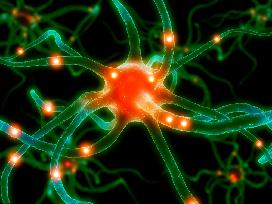Recommended Products
 The nervous system is an internal communication system, relaying signals with short electrical impulses. The central nervous system is composed of the brain and spinal cord. The peripheral nervous system extends to all other parts of the body.
The nervous system is an internal communication system, relaying signals with short electrical impulses. The central nervous system is composed of the brain and spinal cord. The peripheral nervous system extends to all other parts of the body.
Health problems related to the nervous system include stress, insomnia, depression, nervous disorders, headaches and multiple sclerosis.
EXAMINING THE NERVOUS SYSTEM
The nervous system is made up of groups of cells called neurons. A neuron is a cell body with a nucleus, a dendrite (which receives input) and an axon (which relays signals to other cells).
Neurons transmit information through the body in a manner similar to the way electricity flows through a wire. A nervous impulse begins with a reversal of the concentrations of sodium and potassium both inside and outside the neuron. Sodium rushes into the cell and potassium rushes out, generating momentum that conducts an impulse down the axon and toward the dendrite of the next neuron. This transmission continues from cell to cell until the message is delivered. All this takes place at incredible speed.
Some of the spaces between nerve cells, called junctions, are so small that the impulse can travel from one nerve to the next very quickly. These are called gap junctions. However, most neurons relay signals across larger spaces called synaptic junctions. These require chemical messengers called neurotransmitters.
Neurotransmitters are released into a synaptic junction by one cell, and bond with receptors on the membrane of the neighboring cell. After the electronic signal has been relayed, the neurotransmitters are deactivated and recycled. Some neurotransmitters include serotonin, acetylcholine, dopamine, GABA (gamma amino butyric acid) and norepinephrine (noradrenaline). Abnormal. levels of neurotransmitters can cause an assortment of complications. For instance, abnormally low levels of serotonin are associated with obesity depression, sleep disorders, anxiety and migraine headaches.
Many neurons are surrounded by special cells that form an outer layer called the myelin sheath. The myelin is composed mostly of lipids. It insulates the neurons to speed up the conduction of impulses, and it prevents “short circuits” between adjacent neurons. Deterioration of the myelin sheath is associated with many degenerative disorders of the nervous system.
The nervous system has two major divisions—the central nervous system (CNS) and the peripheral nervous system (PNS). The CNS is composed of the brain and spinal cord and is the body’s main signal-processing unit. The nerves of the PNS extend to other parts of the body, including internal organs, skeletal muscles and glands.
The PNS subdivides into the somatic and autonomic pathways. Somatic-pathway responses arc voluntary or conscious. For example, use of arm or leg muscles and sensory perceptions are controlled by somatic nerves. Autonomic pathways deal with involuntary actions like digestion, excretion, heartbeat and the contraction of the smooth muscles. These are all things we can’t control.
Autonomic pathways divide again into the sympathetic and parasympathetic branches of the nervous system. These branches work independently and opposite of one another. The sym pathetic nervous system, which secretes the neurotransmitter noradrenaline, initiates “fight or flight” responses when stimulated by physical, emotional or environmental stress. This is a primitive, instinct-like ability that allows a person to maximize energy in order to most effectively react to stress. It raises blood sugar, heart rate, blood pressure and metabolism, constricts blood vessels and stops less vital functions like digestion. The parasympathetic nervous system normalizes the body by balancing it to the state it was in before the stimulus occurred. The neurotransmitter acety restores non-vital functions. The reciprocating actions of the sympathetic and parasympathetic nervous systems allow the body to cope with stress without being overwhelmed by its physiological effects.
Stress can have many negative effects on the body. In addition to the uncontrollable, physical reactions described above, stress can also deplete levels of water—soluble vitamins (C and B complex) and vitamins A and E. These vitamins are essential to the proper development and function of nervous-system tissue because they act as co-enzymes in chemical reactions and raw materials for nerve cells. Adequate vitamin and mineral intake can help provide the body with the nutrients it needs to function properly, even under stress.